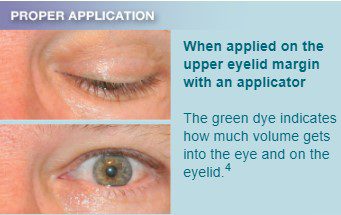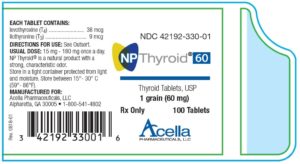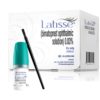LATISSE® (bimatoprost ophthalmic solution) 0.03%
LATISSE® (bimatoprost ophthalmic solution) 0.03% — the first FDA-approved treatment to grow eyelashes for people with inadequate or not enough lashes.
Online staff training
Test yourself. Train the staff. Teach your patients.
The online course helps staff members learn more about how lashes may thin over time and the role of LATISSE® in treating patients with hypotrichosis. With their knowledge, staff members will be able to answer frequently asked questions, explain safety, and more.
After a short quiz, staff members can print their personalized certificates of completion for display in the office.
Remember: Only a healthcare professional can determine who is an appropriate patient and prescribe LATISSE® solution.
Want additional training?
Talk to your Allergan sales representative or call Allergan Customer Service at 1-800-377-7790 to schedule a Staff In-Service today.
Get LATISSE® tools and resources—all in one place
Visit BrandBox online today!
BrandBox is your one-stop shop for LATISSE® materials. You can view and download:
- Logos
- Product photos
- Before and after photos
- Model images
- Application video
- Testimonial videos
- Brochures, counter cards, and other in-office tools
- And more!
Order and prescribe
Offer appropriate patients LATISSE®
Depending on your state’s physician dispensing laws, you can offer LATISSE® by physician dispensing or by having your patients fill their prescription at the pharmacy.
3 ways to order
- Place an order with your Allergan representative.
- Call Customer Service at 1-800-377-7790.
- Visit AllerganDirect.com for online ordering.
LATISSE® (bimatoprost ophthalmic solution) 0.03% is indicated to treat hypotrichosis of the eyelashes by increasing their growth, including length, thickness, and darkness.
Increase fullness, length,
and darkness in 16 weeks1,2
About LATISSE®
Real results in 16 weeks
Over-the-counter products condition eyelashes. In 2008, LATISSE® became the first prescription product FDA approved to grow eyelashes—fuller, longer, and darker—in patients with eyelash hypotrichosis.
- Approximately 8.7 million kits sold
Increase length and darkness and more than double lash fullness in 16 weeks5,6
Paid LATISSE® patient without mascara—lashes not retouched. Individual results may vary.
Upon discontinuation of treatment, eyelash growth is expected to return to its pretreatment level.
Patients should be informed of the possibility of disparity between eyes in length, thickness, pigmentation, number of eyelashes or vellus hairs, and/or direction of eyelash growth.
How LATISSE® works
Helping eyelashes grow fuller, longer, and darker in 16 weeks
Eyelash growth is cyclical.1-3 The normal eyelash growth cycle involves 4 phases—anagen, catagen, telogen, and exogen—and occurs over several months. LATISSE® is believed to prolong the active growth phase—or anagen phase.4

Tell your patients: It takes 16 weeks for full results
It’s important for patients to understand that LATISSE® solution works gradually. While they may start seeing longer lashes after 4 weeks, they must use LATISSE® daily for 16 weeks for maximum results.4,5 They should not reduce or stop daily application of LATISSE® when they first notice results.
Real results in 16 weeks1-3
More than double the fullness • Increase length and darkness
LATISSE® was studied in a multicenter, randomized, double-masked, vehicle-controlled, parallel-group study (N = 278). In the study, 137 patients applied LATISSE® nightly for 16 weeks.1-3
- 78% of the people using LATISSE® (107 out of 137) saw a significant increase in overall eyelash prominence (including elements of fullness, length, and darkness), compared to 18% (26 out of 141) for those who did not use LATISSE®1-3
Lashes also grew1,2:
- 106% fuller (136 LATISSE® patients) vs 12% for the placebo group (140 patients)
- 25% longer (137 LATISSE® patients) vs 2% for the placebo group (141 patients)
- 18% darker (135 LATISSE® patients) vs 3% for the placebo group (138 patients)
91% of the 134 women on LATISSE® in the study were aged 35 or older.4
61.9% had light eyes.4
79.9% were Caucasian, 12.7% were Asian, 4.5% were Hispanic,
and 3% were of a different ethnicity.4
Paid LATISSE® patient without mascara—lashes not retouched. Individual results may vary.
Upon discontinuation of treatment, eyelash growth is expected to return to its pretreatment level.
Patients should be informed of the possibility of disparity between eyes in length, thickness, pigmentation, number of eyelashes or vellus hairs, and/or direction of eyelash growth.
Primary efficacy end point data
78% of patients saw more prominent eyelashes at 16 weeks1-3
In the LATISSE® US phase 3 clinical study (N = 278), the primary efficacy end point was overall eyelash prominence, measured using the Global Eyelash Assessment (GEA) scale.* This photonumeric rating scale ranges from 1 (minimal) to 4 (very marked) and corresponds to frontal and superior eyelash views.2-4
GEA Scale
In the clinical study, an increase in overall eyelash prominence equated to at least a 1-grade increase on the 4-point GEA scale from baseline to the end of the treatment period (week 16).2
78% of LATISSE® patients (107/137) experienced a ≥ 1-grade increase vs 18% for vehicle (26/141). Further, 33% of the LATISSE® patients (45/137) experienced a ≥ 2-grade increase vs 1% for vehicle (2/141) at week 16.1-3
Percentage of patients with eyelash prominence ≥ 1-grade increase from baseline
on the Global Eyelash Assessment (GEA) scale1-3,*
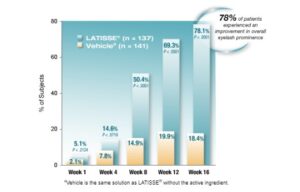
Secondary efficacy end point data
106% fuller, 25% longer, 18% darker at 16 weeks1,2
In the US phase 3 clinical study (N = 278), patients using LATISSE® saw significantly fuller, longer, and darker eyelashes at 16 weeks, contributing to the overall increase in eyelash prominence.1-3
- Eyelashes were significantly longer for LATISSE® patients (n = 137) vs vehicle (n = 141) starting at week 4
- Eyelashes were significantly fuller for LATISSE® patients (n = 136) vs vehicle (n = 140) starting at week 8
- Eyelashes were significantly darker for LATISSE® patients (n = 135) vs vehicle (n = 138) starting at week 8
Full results were seen at 16 weeks. Eyelash fullness, length, and darkness were measured by digital image analysis (DIA).2,3
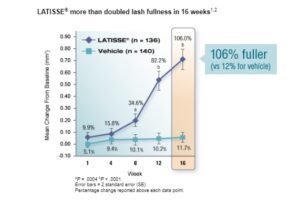


What are the most frequently reported adverse reactions with LATISSE®?
In the clinical study, the following treatment-related adverse events were experienced by fewer than 4% of patients.
The US pivotal clinical study for LATISSE® (N = 278) was a multicenter, randomized, vehicle-controlled, double-masked, parallel study to evaluate the efficacy and safety of LATISSE® for 4 months of treatment.

How to apply
Once daily • 16 weeks • Fuller, longer, darker lashes1-3
Each LATISSE® kit comes with the bottle of solution (3 mL or 5 mL) and sterile applicators. LATISSE® should be applied once a day—at night—following these 5 steps:
 Step 1: Before applying
Step 1: Before applying
Before daily application, the patient ensures face is clean, and makeup and contact lenses are removed.
 Step 2: Prepare the applicator
Step 2: Prepare the applicator
The patient removes a sterile applicator from its tray and, holding it horizontally, places one drop of LATISSE® on the area of the applicator closest to the tip, but not on the tip.
 Step 3: Apply to skin using applicator
Step 3: Apply to skin using applicator
The patient immediately draws the applicator carefully along the skin at the base of the upper eyelashes (where the eyelashes meet the skin) going from the inner part of the lash line to the outer part.
 Step 4: Blot excess
Step 4: Blot excess
The patient blots any excess solution beyond the eyelid with a tissue.
 Step 5: Dispose of applicator
Step 5: Dispose of applicator
The patient disposes of the applicator after one use, then repeats the steps for the opposite eyelid, using a new, sterile applicator to help minimize any potential for contamination from one eyelid to another.
Important reminders
- Apply LATISSE® daily for 16 weeks. Patients should not reduce or stop application when they first notice results
- Patients who miss a dose don’t need to play “catch-up.” They should just apply LATISSE® solution the next day
- Using LATISSE® more than once a day will not increase eyelash growth
- Patients should NOT APPLY LATISSE® directly into the eye or to the lower lid
- It is possible for hair growth to occur on other areas of the skin that LATISSE® solution frequently touches. Blot excess solution with a tissue
- LATISSE® should be applied with the supplied sterile applicators only
- The tip of the bottle or applicator should not touch patients’ fingers or any other unintended surface, as contamination by common bacteria is known to cause infections
- Patients should remove contact lenses prior to application. Contact lenses may be reinserted 15 minutes after application
- If LATISSE® gets in the eye, patients do not need to rinse their eye. It is not expected to cause harm
- If patients stop using LATISSE® solution, lashes will gradually return to their previous appearance
In an ocular splash experiment, a drop of green dye that was the same volume as a drop of LATISSE® was instilled directly in one eye, and a drop of green dye was placed on a sterile applicator brush and applied to the upper eyelid margin of the other eye.4
The results here reinforce how important it is for patients to apply LATISSE® solution to the upper eyelid margin with the provided FDA-approved sterile applicators.
Key fact: When applied to the upper eyelid margin with the applicator, the volume of bimatoprost is approximately 5% of the volume used as an eyedrop.4,5
Remind patients: Do not apply LATISSE® in the eye or to the lower lid.
Is LATISSE® right for your patients?
What to consider when selecting patients for LATISSE®
Market data suggest approximately 27 million women between the ages of 18 and 65 place importance on their eyelashes.1
Remember: Not all consumers are potential LATISSE® patients. Only a physician can determine who is an appropriate patient.
Before prescribing LATISSE® to your patients with eyelash hypotrichosis, discuss ocular health with those who have or have had any of the following2:
LATISSE® is contraindicated in patients with hypersensitivity to bimatoprost or any other ingredient in this product.
Patients who have been previously diagnosed with elevated intraocular pressure (IOP) or have a history of elevated IOP should speak to an eye care specialist prior to starting LATISSE® solution.
Patients who are currently using IOP-lowering medications should speak with an eye care specialist prior to starting LATISSE® solution.
Patients with risk factors for glaucoma or a family history of glaucoma should speak to an eye care specialist prior to starting LATISSE®.
LATISSE® solution should be used with caution in aphakic patients, in pseudophakic patients with a torn posterior lens capsule, or in patients with known risk factors for macular edema.
Pregnancy
There are no adequate and well-controlled studies of bimatoprost ophthalmic solution 0.03% administration in pregnant women. Because animal reproductive studies are not always predictive of human response, LATISSE® should be administered during pregnancy only if the potential benefit justifies the potential risk to the fetus.
It is not known whether LATISSE® solution is excreted in human milk, although in animal studies, bimatoprost has been shown to be excreted in breast milk. Because many drugs are excreted in human milk, caution should be exercised when LATISSE® is administered to a nursing woman.
Safety and effectiveness in pediatric patients have not been established
Before and after: photos
See potential results with LATISSE®
You’ve reviewed the data, now see the results. Patients—just like the women in your office—have used LATISSE® for 16 weeks and seen their lashes grow fuller, longer, and darker.

LATISSE® education
Help patients learn about LATISSE®
In clinical studies, LATISSE® demonstrated proven efficacy and grew lashes fuller, longer, and darker in 16 weeks for patients with eyelash hypotrichosis.1-3 To help your patients have success with LATISSE®, it’s important to educate them about the product and how to use it.
Add LATISSE® to your practice portfolio
Talk to appropriate aesthetic patients about LATISSE®
Did you know market data suggest approximately 27 million women between the ages of 18 and 65 place importance on their eyelashes?1 Offering LATISSE® in your practice could help appropriate patients grow fuller, longer, darker eyelashes in 16 weeks. We want to make it more convenient for you to order and offer LATISSE® by providing you with the resources you need.
IMPORTANT SAFETY INFORMATION
LATISSE® (bimatoprost ophthalmic solution) 0.03% Important Information
Indication
LATISSE® (bimatoprost ophthalmic solution) 0.03% is indicated to treat hypotrichosis of the eyelashes by increasing their growth, including length, thickness, and darkness.
Important Safety Information
Contraindications: LATISSE® is contraindicated in patients with hypersensitivity to bimatoprost or to any of the ingredients.
Warnings and Precautions: In patients using LUMIGAN® (bimatoprost ophthalmic solution) or other prostaglandin analogs for the treatment of elevated intraocular pressure (IOP), the concomitant use of LATISSE® may interfere with the desired reduction in IOP. Patients using prostaglandin analogs including LUMIGAN® for IOP reduction should only use LATISSE® after consulting with their physician and should be monitored for changes to their intraocular pressure.
Increased iris pigmentation has occurred when bimatoprost solution was administered. Patients should be advised about the potential for increased brown iris pigmentation, which is likely to be permanent.
Bimatoprost has been reported to cause pigment changes (darkening) to periorbital pigmented tissues and eyelashes. The pigmentation is expected to increase as long as bimatoprost is administered, but has been reported to be reversible upon discontinuation of bimatoprost in most patients.
There is the potential for hair growth to occur in areas where LATISSE® solution comes in repeated contact with skin surfaces. Apply LATISSE® only to the skin of the upper eyelid margin at the base of the eyelashes.
LATISSE® solution should be used with caution in patients with active intraocular inflammation (eg, uveitis) because the inflammation may be exacerbated. LATISSE® should be used with caution in aphakic patients, in pseudophakic patients with a torn posterior lens capsule, or in patients with known risk factors for macular edema.
Adverse Reactions: The most frequently reported adverse reactions were eye pruritus, conjunctival hyperemia, skin hyperpigmentation, ocular irritation, dry eye symptoms, and periorbital erythema. These reactions occurred in less than 4% of patients.
Postmarketing Experience: The following adverse reactions have been identified during postapproval use of LATISSE®: dry skin of the eyelid and/or periocular area, eye swelling, eyelid edema, hordeolum, hypersensitivity (local allergic reactions), lacrimation increased, madarosis and trichorrhexis (temporary loss of a few eyelashes to loss of sections of eyelashes, and temporary eyelash breakage, respectively), periorbital and lid changes associated with a deepening of the eyelid sulcus, rash (including macular and erythematous), skin discoloration (periorbital), trichiasis, and vision blurred.











